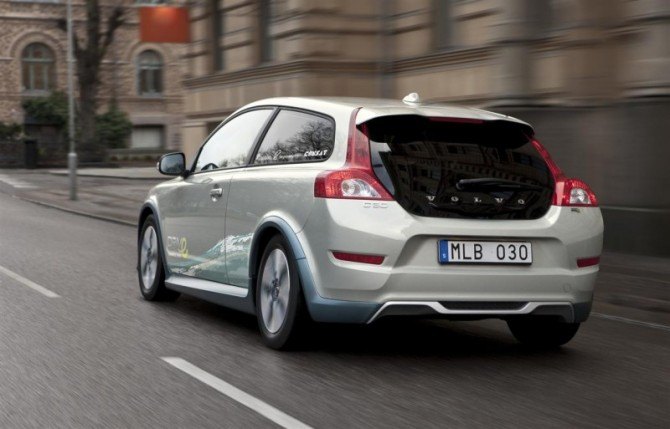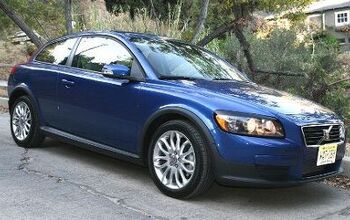Capsule Review: Volvo C30 EV

While at the LA Auto Show in November, TTAC was invited by Volvo to sample the Volvo C30 electric concept car. More a pre-production than concept, the C30 electric will supposedly hit the streets as a 2012 model-year car. So what does the Chinese-Swedish brand, known more for safety than drivetrain innovations, have in store for the electric market? I’m happy to report that the answer is: nothing out of the ordinary.
During our quick 30 minutes spent with the C30 electric and Lennart Stegland, president of Volvo Special Vehicles, the first thing that strikes you about the C30 electric is how normal it is. While Nissan dressed the Leaf in some funky new duds, classily conservative Volvo has “simply electrified” the existing C30. Of course that makes the task sound far simpler than it is as nearly every part of the C30 except the cosmetic items had to be re-engineered to accommodate the 110HP electric drivetrain.
Obviously all electric cars are crash tested, but I have never seen quite the focus on safety that Volvo has brought to the electric car game. Even the formulation of the Lithium-Ion battery has been changed to make the battery unit behave more safely in a collision. Lennart explained that the C30 electric will be just as safe as the C30 which already gets high marks for crash performance.
Out on the road the C30 feels like a golf cart. I was told by Lennart that this was insulting (my apologies), but I have to say that for the average American, a golf cart is the only frame for reference we have for an electric vehicle, so it’s not intended as an insult. What do I mean by a golf cart? Well, the power delivery is seamless and acceleration is extremely linear. Because of the way the C30 electric is programmed, the regenerative braking takes effect as soon as you let off the go pedal reducing the need in normal traffic for using the brake pedal. Fortunately there is a “sailing” mode that disables regenerative braking entirely making the car feel more “normal.” I’m sure it would be easy to get used to this behavior, but at the same time I wish there was a middle option with light regenerative braking. Other than the aggressive regeneration, the 30 drives just like a gasoline C30 when it comes to the curves. I had some limited chances to take it briskly around turns, and despite gaining weight (260lbs) due to the 24 kWh battery pack (from EnerDel) the C30 feels well composed. The C30 electric will never be a hot hatch, but performance is certainly on par with most compact gasoline vehicles available in the US.
Interior quality is high as we have come to expect from Volvo. I could only wish that the Volvo P1 platform interior is scheduled for a serious refresh for 2012 since the S40/V50/C30/C70 interior has been with us for some years. It’s not a bad interior; it’s actually quite competitive even still in terms of fit and finish and design. But change is lovely and after driving the 2011 S60 for a week I am anxious to see what could be done to bring the C30 interior up to date.
Driving range on the C30 electric is expected to be 100 miles according to Lennart. In reality this will vary between 80 and 120 miles depending on your driving style and the weather. It stands to reason that as lithium battery technology improves we should see models with ranges more compatible with American driving styles. My personal daily commute is 82 miles round trip (including going over a 2,200ft mountain pass from sea level) would tax the range of the C30. Round-trip commutes fewer than 60 miles should be free from range-anxiety, but it is still a concern. Since longer commutes are more typical of the American driver than the European driver, I expect adoption rates to be low on this side of the pond until we see a model with a true 200 mile range. Not helping the issue at all is the charging time of any electric vehicle. At 110V it would take almost an entire day to charge any of the all-electric vehicle available or planned for release in the next few years. Unless you have a 220V outlet in your garage or access to a fast charge station (440V) at work, don’t expect to drive to the maximum of your range on a daily basis. For the most part, apartment dwellers need not apply.
It’s good to know Volvo is sticking with the pack on electric car technology; Volvo missed the hybrid bandwagon last decade, but if the C30 electric is any indication is may just be a viable alternative for the urbanite hat has a second set of wheels for road trips. Meanwhile we’re lobbying Volvo for a longer term C30 electric loaner. Stay tuned.
Volvo made the vehicle for this review available at the Los Angeles Auto Show.

More by Alex L. Dykes
Latest Car Reviews
Read moreLatest Product Reviews
Read moreRecent Comments
- Doc423 Rolling Coal is not a bad thing either.
- Ajla In high school I really wanted a yellow GTO.
- Lou_BC Sweet car.
- FreedMike With 157K miles, that's basically a beater that looks good. Plus, I heard Honda CVTs turn dicey with age. I'm a "no" at $12,500, but someone's heart will go all aflutter over the J-vin (Ohio-vin?) and pay up. With a manual in the same shape, I'd be in for a LOT less.
- EBFlex More proof the EV world is crumbling. In a market with supposedly “insatiable demand”, these kinds of things don’t happen. Nor do layoffs.









































Comments
Join the conversation
When I first saw the rear "bucket" seats on the C30, the first thing that I thought is that high tunnel made no sense in a FWD gasser -but a nice place to stuff some batteries and other EV electronics, though.
looks good mate ~ but cant afford one ~ i just hope i can get an iron suit ~ LOL